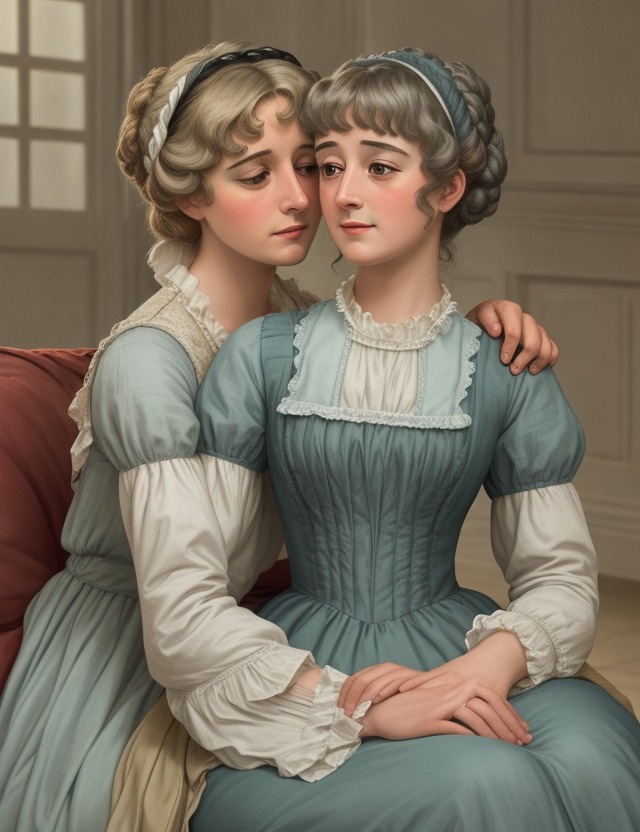Behind the hallowed doors of classic romantic literature lies an enchanting tale that has captivated generations, woven by the accomplished wordsmith, Jane Austen. In her iconic masterpiece, “Sense and Sensibility,” Austen paints a vivid portrait of society’s unforgiving norms, contrasting the delicate balance between reason and emotions through the lives of two remarkable sisters.
As history has proven, Austen’s indelible impact on the literary world stands unrivaled. Join us on a journey back in time, as we delve into the essence of this cherished work, exploring the profound themes, complex characters, and evocative narrative techniques that have made “Sense and Sensibility” an unforgettable masterpiece.
Prepare to be enthralled by an open loop that promises delightful intrigue, as we delve into the essence of “Sense and Sensibility.” In the pages to follow, you will find an insightful recapitulation of the tale that has stood the test of time, enchanting readers with its enchanting characters, gripping plotlines, and timeless messages. So, let us embark together on this literary odyssey, where we uncover the beauty and intellect that lie within the captivating world of Jane Austen.
Sense and Sensibility: Full Book Summary
Once upon a time, in a charming little village called Norland, there lived a joyful family known as the Dashwoods. They consisted of Mr. Dashwood, his lovely wife, and their three daughters: Elinor, Marianne, and Margaret. Their lives were full of love, laughter, and the warmth of their beautiful home.
The Dashwood sisters were as different as could be. Elinor, the eldest, possessed a quiet and sensible nature. She had a calm demeanor and always approached life with logic and reason. Marianne, on the other hand, was full of passion and sensibility. She wore her heart on her sleeve, expressing her emotions freely and without reservation. Lastly, there was young Margaret, innocent and observant, always soaking up the world around her.
Life took an unexpected turn for the Dashwoods when Mr. Dashwood’s health began to decline. Sensing that his time in this world was nearing its end, he called his family together and shared his last wish: that they take care of one another. To ensure their future, he entrusted his estate to their half-brother, John Dashwood, making him the guardian of his wife and daughters.
With a heavy heart, Mr. Dashwood bid his family farewell, leaving behind a void that could never be filled. Shortly after his passing, John Dashwood and his snobbish wife, Fanny, arrived at Norland. The Dashwood women, with their gentle hearts, welcomed them into their home, hoping for a happy coexistence.
However, it soon became apparent that Fanny Dashwood was not the most kind-hearted of individuals. She convinced her husband that his family deserved very little from their late father’s inheritance, leaving the Dashwoods in a position of vulnerability and uncertainty.
Realizing that they had no choice but to leave Norland, Elinor and Marianne, along with their mother and young sister, began the search for a new home. With the help of their cousin, Sir John Middleton, they settled in a cottage in Barton, a peaceful village far from their familiar surroundings.
It was in Barton that the Dashwoods encountered the various characters that would shape their destiny. Among them was Colonel Brandon, an immensely noble and honorable gentleman who was immediately taken with Marianne’s beauty and vivacity. However, Marianne remained oblivious to his affection, as her heart was set on the dashing and charming John Willoughby.
Willoughby, with his sweet words and passionate temperament, soon swept Marianne off her feet. She fell head over heels in love, spending countless hours engaged in deep conversations and romantic strolls through the picturesque countryside. Elinor, ever sensible, observed her sister’s blossoming relationship but couldn’t help but worry about the future.
As the days passed, Willoughby’s behavior became more and more puzzling. It soon became evident that he was not the man Marianne believed him to be. A letter arrived for Marianne, explaining that Willoughby could no longer pursue their relationship and that he was engaged to another woman of significant wealth.
Marianne’s heart was shattered into a million little pieces. She withdrew into herself, lost in a sea of pain and despair. Elinor, determined to support her beloved sister, held her own heartache inside, never revealing her own deep affection for Edward Ferrars, a kind-hearted and honorable man she met during her time at Norland.
Edward, however, faced a predicament of his own. Engaged to Lucy Steele, a woman he had been foolishly infatuated with in his youth, he found himself trapped in a loveless commitment. Frustrated by their current circumstances, Elinor and Edward silently suffered, unable to be together but unable to forget one another either.
As fate would have it, Elinor and Marianne’s lives took another surprising turn when they discovered that they had inherited a vast fortune from a distant relative. This newfound wealth not only provided security for the Dashwood family but also opened up a world of unforeseen opportunities.
In the end, love prevailed, but not in the way one might expect. Marianne, though scarred by her experience with Willoughby, found comfort and companionship in Colonel Brandon, recognizing and appreciating his true qualities of love and loyalty. Their love story blossomed slowly but surely, proving that true love is often found where we least expect it.
Elinor’s patience and unwavering support paid off when Edward finally broke free from his engagement to Lucy Steele. With their hearts now free to fully express their feelings, Elinor and Edward joyfully found their way to one another, promising a future filled with love and understanding.
And so, the Dashwood sisters, after weathering heartbreak, betrayal, and unexpected twists, emerged stronger and wiser. Their journey from sense to sensibility taught them the value of love and loyalty.
Sense and Sensibility: Key Themes
Sense and Sensibility is a novel written by Jane Austen and published in 1811. It tells the story of the Dashwood sisters, Elinor and Marianne, and their experiences with love, heartbreak, and societal expectations in early 19th century England.
The first key theme in Sense and Sensibility is the contrast between sense and sensibility, as reflected in the personalities and actions of the two main characters, Elinor and Marianne Dashwood. Elinor represents sense, which is characterized by rationality, restraint, and practicality. She consistently puts others before herself and embodies stoicism in the face of personal struggles. Marianne, on the other hand, embodies sensibility, which is marked by emotional depth, passion, and sensitivity. She follows her heart and believes in the importance of expressing her emotions openly. Through the contrasting personalities of Elinor and Marianne, Austen explores the balance between reason and emotion and the consequences of leaning too heavily towards one or the other.
The second key theme in the novel is the role of social class and wealth in determining one’s prospects and happiness. The Dashwood sisters are left in reduced circumstances after their father’s death, as their inheritance is entailed to their half-brother. This forces them to seek marriage prospects in order to secure their futures. Throughout the book, Austen critiques the social hierarchy and the limitations it places on women, as they are expected to rely on marriage for financial stability and social standing. The contrast between the upper-class and lower-class characters highlights the disparities in wealth and the social restrictions faced by women of different backgrounds.
Lastly, Sense and Sensibility explores the power dynamics within romantic relationships and the importance of trust and communication. Elinor develops a romantic attachment to Edward Ferrars, but their relationship faces numerous obstacles, including Edward’s engagement to another woman. Elinor shows remarkable resilience and loyalty, even when faced with heartbreak. Marianne, on the other hand, falls passionately in love with the charming but ultimately untrustworthy John Willoughby. Her idealistic pursuit of love leads to disappointment and forces her to reassess her values. Austen emphasizes the importance of discernment, understanding, and open communication in relationships, as well as the consequences of misjudgment and deceit.
In conclusion, Sense and Sensibility explores the conflicts between sense and sensibility, the influence of social class and wealth, and the dynamics of romantic relationships. Through the complex and relatable characters of Elinor and Marianne Dashwood, Austen crafts a story that delves into these timeless themes and offers a nuanced portrayal of love, loyalty, and the societal expectations placed on women.
Sense and Sensibility: Characters
1. Elinor Dashwood: The epitome of sense, Elinor is a calm and collected young woman. With her delicate manners and insightful mind, she finds herself acting as the steady anchor for her family. Her wavy chestnut hair and warm hazel eyes mirror her inner strength. On occasion, Elinor’s affinity for classical literature leads her to recite Shakespearean quotes in the most unexpected situations, much to the amusement of those around her.
2. Marianne Dashwood: The embodiment of sensibility, Marianne is a vivacious and passionate soul. Her long flowing golden locks and piercing blue eyes captivate everyone she meets. Marianne’s poetic nature often finds her lost in her own world, composing heart-wrenching verses on love and nature. She possesses an uncanny ability to attract attention, whether it be through her enchanting piano playing or her occasional bouts of dramatics, much to her practical sister’s chagrin.
3. Colonel Brandon: A distinguished gentleman with salt-and-pepper hair and a strong, rugged build, Colonel Brandon exudes an aura of quiet nobility. Kind and honorable, he has an air of mystery surrounding him. He can often be found seated in the corner of the room, lost in his thoughts, nursing a cup of tea and observing those around him. Despite his reserved demeanor, Colonel Brandon’s secret love for Marianne leads him to make the most endearingly awkward attempts at expressing his affections.
4. John Willoughby: The embodiment of charm and good looks, John Willoughby is a dashing young man with a mischievous grin and tousled dark hair. His flirty nature and passionate disposition draw Marianne into his orbit, making her believe in a whirlwind romance. John’s love for riding horses often leads to comical situations, such as the time he attempted to impress Marianne by attempting a daring jump over a fence, only to end up in a muddy ditch.
5. Edward Ferrars: A reserved and earnest young man, Edward Ferrars possesses an endearing awkwardness that masks his gentle heart. His unruly brown hair and shy, hesitant smile only add to his charm. Despite being bound by societal expectations, Edward dreams of a life where he can pursue his love for literature and freely express himself. His habit of absentmindedly correcting grammatical errors during conversations often leaves others both amused and slightly exasperated.
6. Mrs. Jennings: A lively and talkative widow, Mrs. Jennings constantly seeks to entertain and amuse those around her. Her elaborate hats, filled with colorful plumes, butterflies, and seemingly anything else she can find, are the talk of the town. Mrs. Jennings’ obsession with matchmaking leads her to orchestrate seemingly innocent encounters, often resulting in amusingly awkward situations that she thoroughly enjoys.
7. Lucy Steele: With her carefully styled ringlets and coquettish smile, Lucy Steele is the epitome of a cunning young socialite. Her innocent façade hides a certain scheming nature that she deploys to manipulate others for her own benefit. Lucy’s love for gossip often leads her to acquire amusingly trivial information, such as the color of someone’s petticoat or the brand of lavender water they use.
8. Sir John Middleton: A jovial and boisterous gentleman, Sir John Middleton’s rotund figure and ever-cheerful expression make him a delightful presence. His passionate love for hunting often results in him recounting his thrilling fox chase stories in animated detail, much to the amusement of his guests. Sir John’s inability to remember names accurately turns into a comical recurring joke throughout the story, adding an extra layer of entertainment.
9. Fanny Dashwood: With a perpetually pinched expression and a penchant for condescension, Fanny Dashwood is the embodiment of a snooty socialite. Her perfectly coiffed hair and impeccably fashionable attire only serve to highlight her haughty demeanor. Fanny’s obsession with societal standing often leads her to make hilariously exaggerated exclamations upon hearing of her relatives’ lower-class acquaintances, as if they have personally insulted her lineage.
Sense and Sensibility: Symbols
1) The Dashwood Estate: The Dashwood estate is a symbol of the sisters’ social status and their financial dependence. When their father dies and the estate is inherited by their half-brother, John, who then decides to provide only a small income for his sisters, the symbolism of loss and vulnerability is evident. The loss of the estate forces the Dashwood sisters to seek marriage as a means of security and survival.
2) The Weather: Throughout the book, the weather serves as a symbolic representation of the characters’ internal emotional states. For instance, when Marianne falls into a deep depression after her failed relationship with Willoughby, the rainy and stormy weather reflects her turbulent emotions. Similarly, when Elinor is struggling with her unrequited love for Edward, the winter season reinforces the coldness and despair she feels. The changing weather patterns mirror the characters’ emotional journeys and enhance the overall mood and atmosphere of the story.
3) The Piano: The piano symbolizes both passion and restraint. It is often associated with Marianne, who is depicted as the embodiment of sensibility. Marianne’s skill in playing the piano represents her emotional depth and artistic nature. However, the piano also serves as a reminder of society’s expectation for women to display control and moderation. This is illustrated when Marianne is advised to play “something more cheerful” to mask her true emotions. The piano symbolizes the contrast between the passionate and restrained aspects of Marianne’s character and the conflict between sense and sensibility that shapes the themes of the novel.
Sense and Sensibility: Culture Impact
Sense and Sensibility, written by Jane Austen and published in 1811, has left an indelible mark on culture, showcasing a truly remarkable cultural impact.
Historically, Sense and Sensibility emerged during the Regency era, a period characterized by a shift in societal norms and expectations. Austen’s novel explored themes of love, family dynamics, and the role of women in society. It offered a satirical take on the upper-class lifestyle and provided insight into the social nuances and restrictions placed upon women during this time. Through its witty social commentary, the novel contributed to shaping the understanding of the Regency era.
The book’s impact on culture is also evident through its reception and popularity among readers. Although initially published anonymously, Sense and Sensibility garnered positive reviews and gained a loyal readership. Its engaging plot and relatable characters, like the Dashwood sisters – the sensible Elinor and the impulsive Marianne, captivated readers. The book’s success helped to firmly establish Austen as a prominent author during a time when many female writers received limited recognition. It sparked a flourishing interest in Austen’s works, paving the way for her subsequent novels to make lasting cultural impacts.
Sense and Sensibility’s funny undertones and humorous moments have added to its cultural significance. Austen’s wit and irony cut through societal pretensions, shedding light on the follies and superficiality of certain characters. This cleverness and humor have made the novel enduringly entertaining for readers across generations.
Furthermore, Sense and Sensibility’s achievements extend beyond its initial publication. The novel has been adapted into numerous stage plays, movies, and television series, bringing Austen’s story to life in various formats. These adaptations have further cemented the influence of Sense and Sensibility in popular culture. They have introduced new audiences to the world Austen created, ensuring that the book’s themes and messages continue to resonate today.
In summary, Sense and Sensibility has had an immense cultural impact since its publication. Its exploration of societal norms, witty humor, and relatable characters have contributed to its enduring popularity. Austen’s novel not only shed light on the Regency era but also cemented her place as a literary icon. The book’s influence continues to shape popular culture, captivating audiences through stage productions and screen adaptations. Sense and Sensibility remains a timeless work that has left an indelible mark on our collective consciousness.
FAQs
1. What is the main plot of “Sense and Sensibility”?
“Sense and Sensibility” follows the lives of the Dashwood sisters, Elinor and Marianne, as they navigate love, societal expectations, and financial struggles after their father’s death. The novel explores the contrasting personalities of the two sisters and their different approaches to romance and relationships.
2. Who are the main characters in “Sense and Sensibility”?
The main characters in “Sense and Sensibility” include the Dashwood sisters, Elinor and Marianne, along with their mother, Mrs. Dashwood. Other significant characters include Edward Ferrars, Colonel Brandon, John Willoughby, and Lucy Steele, who each play pivotal roles in the sisters’ lives.
3. What is the significance of the title “Sense and Sensibility”?
The title refers to the contrasting characteristics of the two main characters, Elinor (sense) and Marianne (sensibility). Elinor represents rationality, restraint, and practicality, while Marianne embodies emotion, passion, and romantic ideals. The novel explores the balance between these two qualities and the consequences of leaning too much towards either extreme.
4. What themes are explored in “Sense and Sensibility”?
“Sense and Sensibility” explores themes such as love, marriage, societal expectations, gender roles, and class distinctions. It delves into the challenges faced by women in the early 19th century and the choices they had to make in terms of marrying for love or financial security. The novel also examines the complexities of relationships and the consequences of rash decisions.
5. What is the writing style of “Sense and Sensibility”?
“Sene Sensibility” is written in a realistic and psychological style, typical of Jane Austen’s works. The novel focuses on character development and internal emotions, providing insights into the thoughts and feelings of the protagonists. Austen’s writing is known for its wit, social commentary, and intricate plotting, elements that are present in “Sense and Sensibility” as well.










